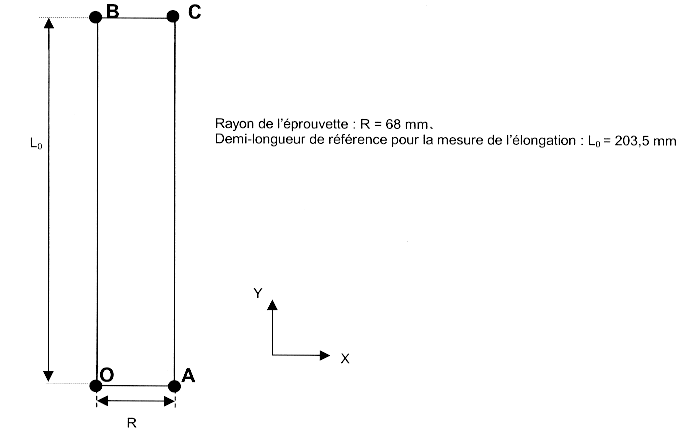1. Reference problem#
1.1. Geometry#
A smooth cylindrical half-test specimen is considered.

1.2. Material properties#
A Von Mises elasto-plastic behavior law with linear isotropic work hardening “VMIS_ISOT_LINE” is adopted. The deformations used in the behavior relationship are linearized deformations.
The Young’s modulus \(E\), the tangent modulus \({E}_{t}\) and the Poisson’s ratio do not depend on temperature. We take: \(E\mathrm{=}200\mathit{GPa}\), \({E}_{t}\mathrm{=}2000\mathit{MPa}\) and \(\nu \mathrm{=}\mathrm{0,3}\).
The evolution of the elastic limit with temperature is given in the following table:
Temperature \(\mathrm{[}°C\mathrm{]}\) |
— 150 |
— 100 |
— 50 |
— 50 |
\({\sigma }_{Y}\mathrm{[}\mathit{MPa}\mathrm{]}\) |
750 |
700 |
700 |
650 |
Finally, thermal expansion is neglected (thermal expansion coefficient taken to be equal to 0).
1.3. Boundary conditions and loads#
With reference to the figure in [§1.1] the boundary conditions are as follows:
on the surface \(\mathit{SSUP}\) \(\mathit{BC}\) (\(Y\mathrm{=}{L}_{0}\)) displacement
imposed in the direction \(\mathit{OY}\),
on the surface \(\mathit{SINF}\) \(\mathit{OA}\) (\(Y\mathrm{=}0\)) blocked movements in direction \(\mathit{OY}\),
\(A\) movements blocked following \(X\) and \(Z\),
\(B\) movements blocked following \(Z\).
The temporal evolution of temperature (assumed to be homogeneous in the test piece) and of elongation
are shown in the following table:
Time \(\mathrm{[}s\mathrm{]}\) |
10 |
20 |
30 |
40 |
Temperature \(\mathrm{[}°C\mathrm{]}\) |
—50 |
—50 |
—150 |
—150 |
Displacement |
20,35 |
20,30 |
20,30 |
32,525 |
1.4. Initial conditions#
Zero stresses and deformations.